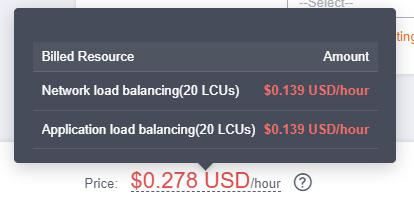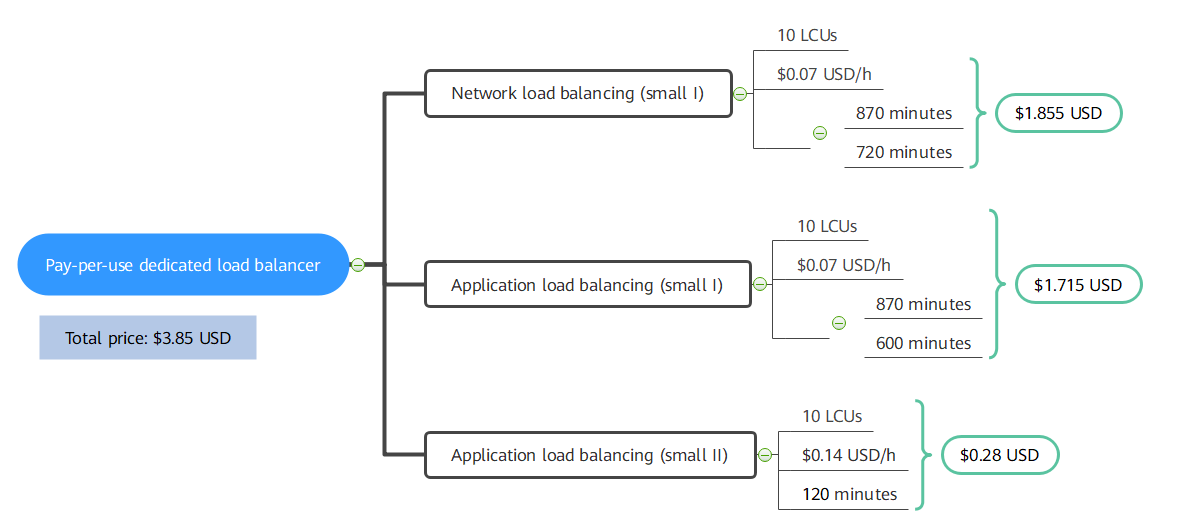Pay-per-Use Billing
Pay-per-use billing means you pay nothing up front and are not tied into any contract or commitment. This section describes the billing rules for pay-per-use load balancers.
Application Scenarios
Pay-per-use is suitable for applications or services that cannot be interrupted when facing temporary or sudden traffic increases or unpredictable demands, such as e-commerce flash sales, testing, and scientific computing.
Billing Items
Table 1 lists the billing items of pay-per-use load balancers.
|
Load Balancer Type |
Specification Type |
LCU |
Load Balancer |
|---|---|---|---|
|
Dedicated |
Elastic |
√ |
√ |
|
Fixed |
√ |
× |
|
|
Shared |
Fixed |
× |
√ |
If you purchase a dedicated load balancer with fixed specifications, deploy it in two AZs, and select small I for both application load balancing and network load balancing, the prices are as shown in the following figure.

You are charged for:
- Network load balancing: 20 LCUs (10 LCUs for each AZ).
- Application load balancing: 20 LCUs (10 LCUs for each AZ).

- If you deploy a dedicated load balancer in multiple AZs, its performance will multiply as the number of AZs increases. The number of LCUs is calculated as follows: Number of LCUs = LCUs of the selected specification × Number of the selected AZs.
- If you bind an EIP to this load balancer, you will also be charged for the EIP and the bandwidth used by the EIP. For details about EIP pricing, see EIP Pricing Details.
Billed Usage Period
Pay-per-use load balancer usage is calculated by the second and billed every hour. The billing starts when the load balancer is created and ends when it is deleted.

The billing starts from the creation time on the load balancer Summary page.
For example, if you purchased a pay-per-use load balancer at 8:45:30 and deleted it at 8:55:30, you are billed for the 600 seconds from 8:45:30 to 8:55:30.
Billing Examples
Suppose you purchased a pay-per-use load balancer with fixed specifications at 9:30:00 on April 18, 2023, deployed it in one AZ, and selected small I for both application load balancing and network load balancing types. Later you upgraded small I to small II for application load balancing at 10:00:00 on April 19, 2023 and deleted the load balancer at 12:00:00 on April 19, 2023.
The total price you need to pay is calculated as shown in the below table.
|
Billing Item |
Required Duration |
Pricing Details (USD) |
Total Price (USD) |
|---|---|---|---|
|
Network load balancing (10 LCUs) |
|
1.015 + 0.84 = 1.855 |
|
|
Application load balancing (10 LCUs) |
|
1.015 + 0.7 = 1.715 |
|
|
Application load balancing (20 LCUs) |
2023/04/19 10:00:00 – 2023/04/19 12:00:00 120 minutes |
(120/60) × 0.14= 0.28 |
0.28 |
Figure 2 shows how the total price is calculated.

The prices in the figure are for reference only. The actual calculation is subject to the prices in the ELB Pricing Details.
Price Change After Specification Change
If you change the specifications of a pay-per-use load balancer, the original order will become invalid and a new order will be placed. You will be billed based on the new specifications.
If you change specifications within a given hour, multiple records will be generated. Different records record the billing for different specifications.
Assume that you purchased a pay-per-use load balancer at 9:00:00, deployed it in two AZs, and selected small I for both application load balancing and network load balancing. Later you upgraded small I to small II for both application load balancing and network load balancing. The following items are billed:
- Usage of a small I application load balancer and small I network load balancer from 9:00:00 to 9:30:00
- Usage of a small II application load balancer and small II network load balancer from 9:30:00 to 10:00:00
Impact of Arrears
Figure 3 shows the statuses a pay-per-use load balancer can have throughout its lifecycle. After a load balancer is purchased, it enters the valid period and runs normally during this period. If your account goes into arrears, the load balancer enters a grace period and then a retention period.
Arrears Reminder
The system will bill you for pay-per-use load balancers after each billing cycle ends. If your account goes into arrears, we will notify you by email, SMS, or in-app message.
Impacts of Arrears
If your account is insufficient to pay your amount due, your account goes into arrears, and pay-per-use load balancers enter the grace period. You are still responsible for expenditures generated during the grace period. You can view the charges on the Billing > Billing Center > Overview page and pay any past due balance as needed.
If your account is still in arrears after the grace period ends, your load balancers enter the retention period and their status turns to Frozen. You cannot perform any operations on them.
After the retention period ends, your load balancers will be released and data cannot be restored.

- For details about the grace period and retention period, see What Is a Grace Period of Huawei Cloud? How Long Is It? and What Is a Retention Period of Huawei Cloud? How Long Is It?
- For details about topping up your account, see Topping Up an Account.
Feedback
Was this page helpful?
Provide feedbackThank you very much for your feedback. We will continue working to improve the documentation.See the reply and handling status in My Cloud VOC.
For any further questions, feel free to contact us through the chatbot.
Chatbot







